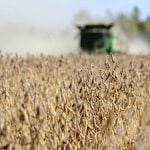A government economist says contrary to industry expectations, there is little chance soft white spring wheat will make dramatic inroads into the ethanol sector.
While it may be well suited for biofuel production from an agronomic perspective, the price the ethanol industry is willing to pay for feedstock is too low for the high cost wheat.
“It is only a one percent return on investment for the guys growing wheat under irrigation,” said Prairie Farm Rehabilitation Administration economist Harvey Clark, who investigated the subject in his previous job at the Canada-Saskatchewan Irrigation and Diversification Centre in Outlook, Sask.
Read Also

Chinese offer complicates canola marketing
Recently the Chinese ambassador indicated that there would be a potential deal between Canada and China regarding the current tariff war.
Feed wheat now sells for about $113 per tonne delivered at Outlook. That barely covers the cost of producing the crop under irrigation, said Clark.
“There’s going to be a natural disincentive there,” he said.
His findings fly in the face of industry expectations.
Andy Kovacs, executive director of the Alberta Soft Wheat Producers Commission, said with its extreme yields and high starch content, the crop is ideally suited to the burgeoning biofuel industry.
“Certainly we have a very big opportunity as far as ethanol is concerned,” said Kovacs. He expects next year’s soft white wheat acreage will be up 79 percent over the five-year average, due in a large part to its potential as an ethanol feedstock.
At current prices for feed wheat, it would be uneconomical for CPS red and white wheat growers to deliver their product to ethanol plants, but that is not the case for soft white wheat producers who realize a substantial yield benefit over their counterparts, said Kovacs.
With varieties like AC Andrew capable of delivering 140 bushels per acre under irrigation, there is more margin to work with.
“You’re making a sizable profit even on ethanol.”
Kovacs suspects Clark is working with outdated yield numbers. He noted that breeders are working on lines that could bring yields up to the 170-200 bu. per acre range.
“It is going to be darn profitable to be doing ethanol using soft white spring wheat,” he said.
That said, today’s feed values do not compare favourably to the Canadian Wheat Board’s price for soft white wheat headed for human consumption markets. According to the latest Pool Return Outlook, it is selling for $181 per tonne at port.
But Kovacs noted the wheat used in ethanol production will be grown close to the plants, so there will be lower transportation costs. There is also no dockage, brokerage fees or checkoffs to worry about. So it could be an attractive alternative for farmers who don’t like dealing with the CWB.
He would like to see the feed price for soft white spring wheat rise above today’s values to make it even more competitive. He thinks that will happen once ethanol plants realize the benefits of using the high starch crop as a feedstock.
But Clark figures it would have to reach $150 per tonne to build in an adequate return for farmers with irrigation. At that value, the crop wouldn’t make economic sense for the ethanol plants.
They are generating revenues of about 60 cents per litre for their fuel, while the cost of production is about 46 cents per litre. Hiking up the price of soft white wheat to an acceptable level for farmers would add another 10 cents per litre to the cost of production.
“It would just take the wind out of the sails on ethanol,” said Clark.
As a result, he can’t see much of a future for soft white wheat in the biofuel business.
“It is tough, especially under irrigation, to make that one work.”















